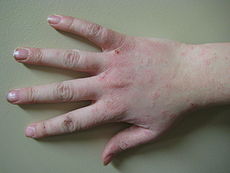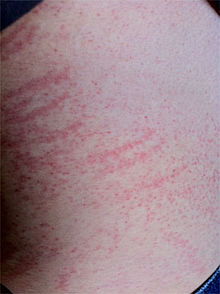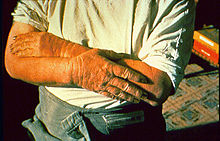- Dermatitis
-
Dermatitis Classification and external resources
Dermatitis of the hand.ICD-10 L20-L30 ICD-9 692.9 MeSH D003872 Dermatitis is inflammation of the skin (i.e. rash).
Contents
Etymology
Dermatitis derives from Greek derma "skin" + -itis "inflammation" and genetic disorder.
Terminology
There are several different types of dermatitis. The different kinds usually have in common an allergic reaction to specific allergens. The term may describe eczema, which is also called dermatitis eczema and eczematous dermatitis. An eczema diagnosis often implies atopic dermatitis (which is very common in children and teenagers) but, without proper context, may refer to any kind of dermatitis.[1]
In some languages, dermatitis and eczema are synonyms, while in other languages dermatitis implies an acute condition and eczema a chronic one.[2] The two conditions are often classified together.
Classification
Types of dermatitis are classified according to the cause of the condition.
Contact dermatitis is caused by an allergen or an irritating substance. Irritant contact dermatitis accounts for 80% of all cases of contact dermatitis.[3]
Atopic dermatitis is very common worldwide and increasing in prevalence. It affects males and females equally and accounts for 10%–20% of all referrals to dermatologists.[4] Individuals who live in urban areas with low humidity are more prone to develop this type of dermatitis.
Dermatitis herpetiformis appears as a result of a gastrointestinal condition, known as celiac disease.
Seborrheic dermatitis is more common in infants and in individuals between 30 and 70 years old. It appears to affect primarily men and it occurs in 85% of people suffering from AIDS.[citation needed]
Nummular dermatitis is a less common type of dermatitis, with no known cause and which tends to appear more frequently in middle-age people.
Stasis dermatitis is an inflammation on the lower legs which is caused by buildups of blood and fluid and it is more likely to occur in people with varicose.
Perioral dermatitis is somewhat similar to rosacea; it appears more often in women between 20 and 60 years old.
Infective dermatitis is dermatitis secondary to a skin infection
Signs and symptoms
Dermatitis symptoms vary with all different forms of the condition. They range from skin rashes to bumpy rashes or including blisters. Although every type of dermatitis has different symptoms, there are certain signs that are common for all of them, including redness of the skin, swelling, itching and skin lesions and sometimes oozing and scarring. Also, the area of the skin on which the symptoms appear tends to be different with every type of dermatitis.
The symptoms of contact dermatitis usually appear at the site where the allergen got into contact with the skin. Also, the symptoms of neurodermatitis are limited to a single area, often the neck, wrist, forearm, thigh or ankle. More rarely, the primary symptom of this condition which is itchy skin may appear on the genital area, such as the vulva or scrotum. [5] Symptoms of this type of dermatitis may be very intense and may come and go. Irritant contact dermatitis is usually more painful than itchy.
Although the symptoms of atopic dermatitis vary from person to person, the most common symptoms are dry, itchy, red skin. Typical affected skin areas include the folds of the arms, the back of the knees, wrists, face and hands. Less commonly there may be cracks behind the ears, and various other rashes on any part of the body. [6] Itching is the primary symptoms of this condition.
Dermatitis herpetiformis symptoms include itching, stinging and a burning sensation. Papules and vesicles are commonly present. The small red bumps experienced in this type of dermatitis are usually about 1 cm in size, red in color and may be found symmetrically grouped or distributed on the upper or lower back, buttocks, elbows, knees, neck, shoulders, and scalp. [7] Less frequently, the rash may appear inside the mouth or near the hairline.
The symptoms of seborrheic dermatitis on the other hand, tend to appear gradually, from dry or greasy scaling of the scalp (dandruff) to hair loss. In severe causes, pimples may appear along the hairline, behind the ears, on the eyebrows, on the bridge of the nose, around the nose, on the chest, and on the upper back. [3] In newborns, the condition causes a thick and yellowish scalp rash, often accompanied by a diaper rash.
Perioral dermatitis refers to a red bumpy rash around the mouth. [8]
Causes
A number of health conditions, allergies, genetic factors and irritants can be responsible for causing dermatitis. There are several types of dermatitis which are distinguished based on the factor that triggers the skin reaction.
Cleaning products like:
- skin soaps
- detergents
- laundry soap or
- bleach
may cause contact dermatitis.
This specific type of dermatitis can also be caused by the exposure to allergens such as:
- rubber,
- metal (nickel),
- jewelry,
- cosmetics,
- fragrances and perfume,
- weeds (such as poison ivy) or
- a common ingredient found in topical antibiotic creams: neomycin.
Individuals develop this condition due to a brief exposure to the allergen or to a prolonged exposure to an irritant, such as those mentioned above. Generally, people who become sensitive to an allergen will be allergic to it for the rest of their lives.
Dry skin, chronic irritation, eczema and psoriasis are possible causes of neurodermatitis.[9]
Studies have shown that long term use of topical steroid cream, often used to treat atopic dermatitis, can make the condition much worse. Total cessation of the use of topical steroid cream can lead to cure, although there is a period of severe 'rebound' between the cessation of the use of topical steroid cream and the cure.[10]
Another type of dermatitis, seborrheic dermatitis is usually caused by physical stress, neurological conditions such as Parkinson's disease or by traveling. Varicose veins and chronic conditions or infections that affect the blood flow in the legs account for potential causes of stasis dermatitis.
The cause of atopic dermatitis is not known, but the disease seems to result from a combination of genetic (hereditary) and environmental factors.[11] Usually, an irritable skin, a poor immune system and a genetic factor are included among the causes of this condition. Although stress does not cause this type of dermatitis, it has been proven to worsen it. Not least, makeup, moisturizers, topical corticosteroids and dental products that contain fluoride may cause perioral dermatitis.
Dermatitis herpetiformis is caused by a gastrointestinal condition called celiac disease. Celiac disease often results after the ingestion of aliments that contain gluten.
Treatment
Treatment of dermatitis is made accordingly with the particular cause of the disease. Creams that contain corticosteroids, wet compresses and avoiding the allergens and irritants are part of most treatment plans. For some types of dermatitis, nonsteroidal medications may help relieve signs and symptoms. And for all types of dermatitis, occasional use of over-the-counter antihistamines can reduce itching. [12]
See also
- Contact dermatitis
- Grant v The Australian Knitting Mills
- Interdigital dermatitis in cattle
- List of skin diseases
References
- ^ ICD 10: Diseases of the skin and subcutaneous tissue (L00-L99) > Dermatitis and eczema (L20-L30)
- ^ Johannes Ring; Bernhard Przybilla; Thomas Ruzicka (2006). Handbook of atopic eczema. Birkhäuser. pp. 4. ISBN 9783540231332. http://books.google.com/?id=jTktMX60bPwC&pg=PA4. Retrieved 4 May 2010.
- ^ a b "Dermatitis". http://www.merckmanuals.com/home/skin_disorders/itching_and_noninfectious_rashes/dermatitis.html. Retrieved 2010-11-06.
- ^ "How common is atopic dermatitis?". http://www.medicinenet.com/atopic_dermatitis/page2.htm#3howcommon. Retrieved 2010-11-06.
- ^ "Neurodermatitis". http://www.mayoclinic.com/health/neurodermatitis/ds00712/dsection=symptoms. Retrieved 2010-11-06.
- ^ "What are the symptoms of atopic dermatitis?". http://www.medicinenet.com/atopic_dermatitis/page3.htm#6whatare. Retrieved 2010-11-06.
- ^ "Contact Dermatitis Pictures". http://www.dermatitispictures.net/. Retrieved 2010-11-06.
- ^ "Symptoms". http://www.mayoclinic.com/health/dermatitis-eczema/DS00339/DSECTION=symptoms. Retrieved 2010-11-06.
- ^ "Dermatitis". http://www.mayoclinic.com/health/dermatitis-eczema/ds00339/dsection=causes. Retrieved 2010-11-06.
- ^ url=http://kellypalace61.web.officelive.com/Documents/CorticosteriodAddictionArticle.pdf
- ^ "What causes atopic dermatitis?". http://www.medicinenet.com/atopic_dermatitis/page2.htm#4whatcauses. Retrieved 2010-11-06.
- ^ "Treatments and drugs". http://www.mayoclinic.com/health/dermatitis-eczema/ds00339/dsection=treatments-and-drugs. Retrieved 2010-11-06.
External links
- Skin Exposures and Effects National Institute for Occupational Safety and Health
- NIH/Medline
- CRISP Thesaurus 00017035
Dermatitis and eczema (L20–L30, 690–693,698) Atopic dermatitis Besnier's prurigoSeborrheic dermatitis Pityriasis simplex capillitii · Cradle capContact dermatitis
(allergic, irritant)other: Abietic acid dermatitis · Diaper rash · Airbag dermatitis · Baboon syndrome · Contact stomatitis · Protein contact dermatitisEczema Autoimmune estrogen dermatitis · Autoimmune progesterone dermatitisBreast eczema · Ear eczema · Eyelid dermatitis · Hand eczema (Chronic vesiculobullous hand eczema, Hyperkeratotic hand dermatitis)Autosensitization dermatitis/Id reaction (Candidid, Dermatophytid, Molluscum dermatitis) · Circumostomy eczema · Dyshidrosis · Juvenile plantar dermatosis · Nummular eczema · Nutritional deficiency eczema · Sulzberger–Garbe syndrome · Xerotic eczemaPruritus/Itch/
PrurigoDrug-induced pruritus (Hydroxyethyl starch-induced pruritus) · Senile pruritus · Aquagenic pruritus (Aquadynia)Adult blaschkitis · due to liver disease (Biliary pruritus · Cholestatic pruritus) · Prion pruritus · Prurigo pigmentosa · Prurigo simplex · Puncta pruritica · Uremic pruritusOther/ungrouped substances taken internally: Bromoderma · Fixed drug reactionCategories:- Dermatitis
- Inflammations
Wikimedia Foundation. 2010.



